If you love house plants, you should try Calathea Dottie. This very attractive foliage plant has a reputation for being fussy, which is why a lot of beginners are hesitant to try it. But with dedication and careful attention, this house plant will surely be a stunning additional attraction to your collection of indoor plants.
Here are the factors to consider in taking care of Calathea Dottie (Rose Painted Calathea Dottie):
- Right Potting Soil
- Proper Lighting
- Temperature and Humidity
- Water Supply
- Pruning and Fertilizing
Collecting Calathea plants can be challenging due to their strict care requirements. But while there is no exact science when it comes to growing them, they will immediately show some signs if you are doing it wrong. Lucky for you, this comprehensive guide will teach you everything about planting Calathea Dottie.
What Is a Calathea Dottie?
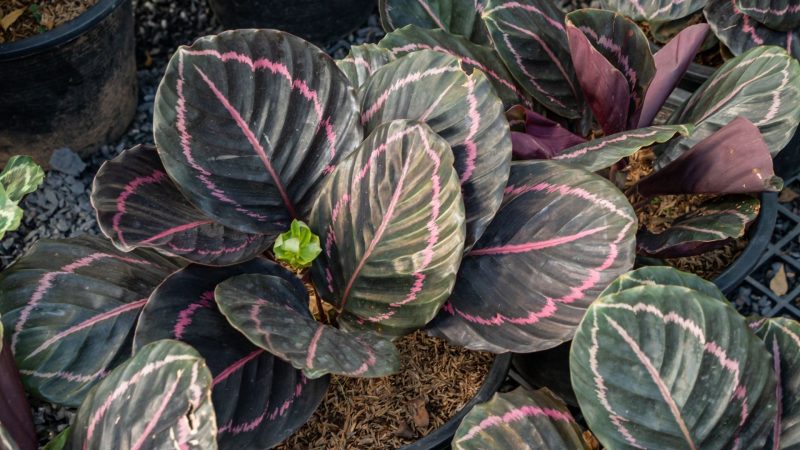
Calathea roseopicta ‘Dottie’ is a variety bred from Calathea roseopicta, also called Rose Painted Calathea. All the members of Calathea genus, including Calathea Dottie belong to the Marantaceae family. Considered one of the most beautiful tropical plants in the world, this evergreen perennial is native to Brazil.
Interestingly, Calathea plants are also called prayer plants because their oval leaves are flat and open in the day and hold each other at night as if they are praying. Each deep greenish-black leaf of Calathea Dottie species has a fuchsia pink outline that looks like another leaf, while its underside is flashy deep purple.
How Many Types of Calathea Are There?
Currently, there are about 60 different types or species of Calathea genus, and Calathea roseopicta is only one of them. There used to be around 300 species, but a team of taxonomists redefined the generic limits of Calathea. Their study suggested that 246 of these species now belong to the Goeppertia genus.
Are Calathea Dottie Plants Rare?
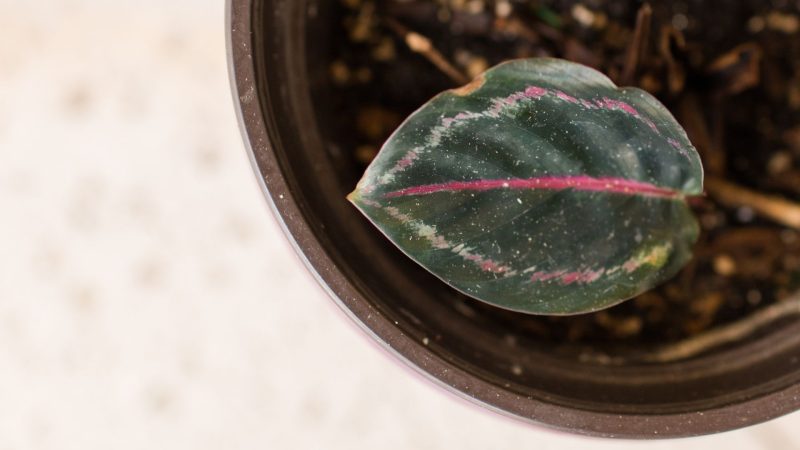
Calathea Dottie is not considered a rare plant. Actually, this gorgeous plant is so popular these days, and you can easily buy it online. Among the other common Calathea plants are Calathea Lancifolia, Calathea Zebrina, Calathea Makoyana, and Calathea Crocata. The price range is from $20 to $40 each.
Is Calathea Dottie Difficult to Take Care Of?
Calathea Dottie and all types of Calathea plants are somehow difficult to take care of compared to other house plants. This is because they have some special needs, which can be tricky to manage. Therefore, you should follow all the requirements religiously if you want to have them as your house plants.
Best Locations for Growing Calathea Dottie
If you want your Calathea Dottie to grow healthy, the best locations to plant them are in shady rooms without direct sunlight. Place their pots 6 to 10 feet away from the window, not facing the south, especially during hot seasons. If you place them inside a bright room, there should be enough space for artificial lights.
Likewise, Calathea plants should not be placed near high-intensity lights or any heating system. Instead, they prefer humid areas such as bathrooms, where they can grow naturally. In the winter, you can place your Calathea Dottie near the windows. Despite being dormant, they will still need some bright lights.
Calathea Dottie Care | A Detailed Guide
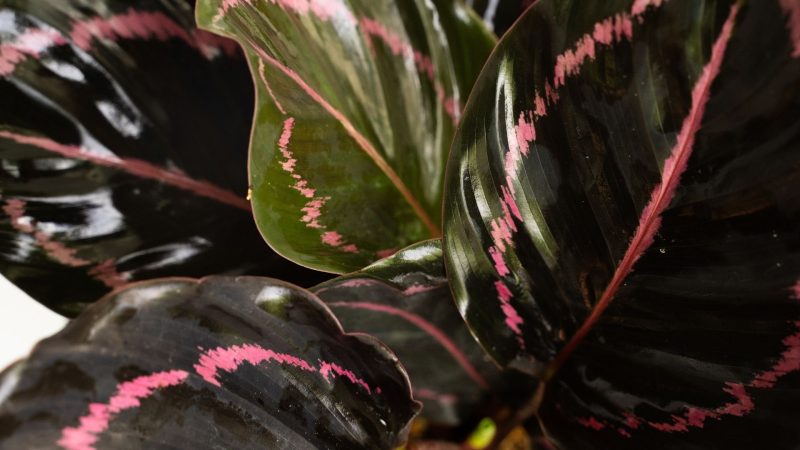
In general, Calathea plants need special care and attention. These eye-catching plants grow easily if the required conditions are met. Although they are usually found in greenhouses, you can also take care of them as indoor, ornamental plants. Below are the important factors that affect the growth of Calathea Dottie:
1. Right Potting Soil
Calathea Dottie prefers well-draining, slightly acidic soil with a pH level of around 6.5. You can use a general-purpose potting mix, but adding 1/3 perlite to improve drainage would be better. Calathea plants dislike wet soil, so make sure that the drainage holes at the bottom of the pots are big enough to drain properly.
Once the potting mix is poorly aerated (too much water), it will be too compact and will lack oxygen but will contain excess carbon dioxide. As a result, the plant will not receive enough nutrients and will stunt its growth. If adding perlite is not that effective, try adding fine gravel or shredded bark to create more air spaces.
2. Proper Lighting
Direct sunlight kills Calathea Dottie, as well as any type of Calathea plant. In the wild, they grow under a canopy of trees or shaded areas because sun rays are too harsh, causing them to lose their vibrant colors. Too much sun exposure can also burn their leaves, preventing them from growing, and they will eventually die.
To mimic their natural needs for light, find a spot where Calathea Dottie will receive medium light. If you are living in the Northern Hemisphere countries, such as in the United States, south-facing windows get the most sunlight. For this reason, you better place your Calathea plants near the windows that are facing the north or east.
3. Temperature and Humidity
The ideal temperature range for Calathea Dottie is 64 – 75ºF (18 – 24ºC), but it’s better to be on the warmer side. Calathea plants cannot tolerate cold drafts, blowing heat from heaters, and temperatures below 60°F (15°C). Nonetheless, they can still survive in the winter but are dormant and grow very slowly.
Calathea plants can still tolerate 40% in terms of humidity, but they prefer 60% and above. There are three known ways to increase humidity in the room – misting the plant, putting the plant on a tray with pebbles, and using a humidifier. They all work well, but only the humidifier can consistently increase humidity. To elaborate further, see the following:
Misting Calathea Dottie
Misting Calathea Dottie or any indoor plant effectively increases humidity, but only for a short time. Once you mist a plant, the water (or any liquid) you sprayed on the plant will provide moisture in the form of droplets. But sooner or later, the water will evaporate, and the humidity level will go down dramatically.
Using a Pebble Tray
In this technique, you will place the potted Calathea Dottie on a tray (or saucer or shallow dish) with water and add some pebbles to it. But while it can also increase humidity in the room, the water will soon evaporate, just like what will happen in misting the plant. Therefore, you need to add water from time to time.
Using a Humidifier
Using a humidifier such as LEVOIT Humidifiers is the best way to increase humidity for your Calathea Dottie. Simply place it on elevated-level surfaces such as nightstands and tables and run it based on the product instructions. To get an accurate humidity measurement, you can use an ordinary hygrometer.
4. Water Supply
Calathea Dottie is a very thirsty plant and needs a regular water supply. The frequency of watering your plant depends on the season of the year. It can be every day, every other day, every week, etc. The key here is to allow consistent moisture without making the soil soggy or dry. Otherwise, your plant will die.
If the holes on the pot are too big for the soil, place a paper towel before putting the plant to ensure proper drainage for the water. Also, avoid using tap water because it contains salt that can build up in the soil and can harm your plant. To make sure that the water quality is high, use filtered or distilled water.
5. Pruning and Fertilizing
Calathea Dottie does not need regular pruning. But sometimes, your plant will have damaged or dead leaves, and you should cut them. Pruning yellow (or brown) leaves is a must to avoid damage to other leaves. The dying leaves will also use energy, which new and growing leaves should rather use.
Similarly, Calathea Dottie seldom needs fertilization. Once they do, you can use any kind of general houseplant fertilizer with a balanced ratio of NPK – nitrogen, phosphate, and potash (potassium). Ideally, it would be best to fertilize Calathea plants when they are actively growing – from the middle of spring until late summer.
How to Propagate a Calathea Dottie?
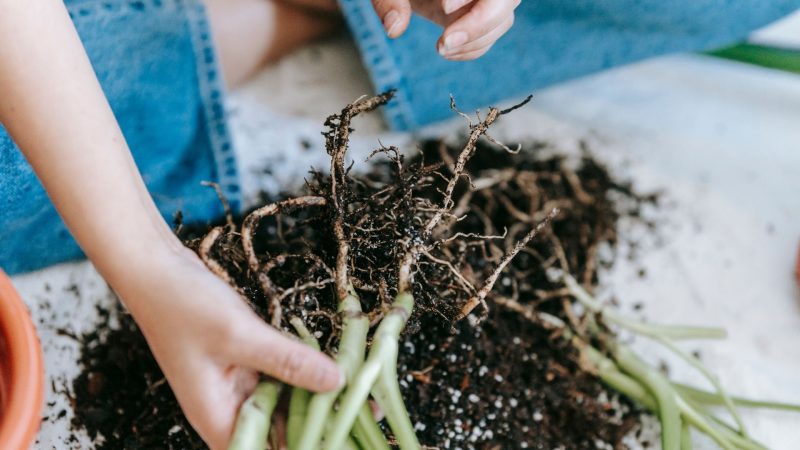
Propagating a Calathea Dottie is done through root division. You cannot propagate this house plant by cutting a stem or leaf and planting it because neither of them has the correct tissue to grow into a new plant. Below are the steps on how to propagate a Calathea Dottie:
Step 1: Water your Calathea Dottie the day before you propagate the plant. This will help the plant in reducing stress and recover faster.
Step 2: Prepare pots with fresh soil. They should have enough holes for drainage and should be a few inches wider than the root ball of your plants.
Step 3: Remove the plant gently from its container. To protect the leaves, use one hand to hold the stems while the other hand is slowly lifting the plant.
Step 4: While separating the roots, make sure that each clump has a root system.
Step 5: If necessary, cut the root system for proper division without breaking them.
Step 6: Remove loose soil and damaged or diseased roots, if there are any.
Step 7: Place your new plant and the mother plant in their new pots.
Step 8: Water your new Calathea Dottie, but allow excess water to drain fast.
Step 9: Place the pot under indirect sunlight but with a lower level of light as compared to its mother plant.
Step 10: To increase humidity, cover the new plant with a clear plastic bag until it starts to grow, which is usually within 2 – 4 weeks.
Step 11: Water your new plant just like you do with your other Calathea plants.
How to Fertilize Your Calathea Dottie?
Generally speaking, all types of Calathea plants don’t need fertilizer that much. Applying too much fertilizer can cause their leaves to burn and the death of your plant. With that, here are some helpful tips on how to fertilize Calathea Dottie:
- Fertilize Calathea plants monthly, from April to August.
- Fertilization is not necessary during winter because this is their dormant season.
- Use a quick-release fertilizer with a balanced NPK ratio, for example, 15-15-15.
- To prevent the burning of roots, water your plant deeply and let the soil absorb the water before you apply fertilizer.
- Mix the fertilizer with clean water. If possible, use filtered water instead of tap water.
- Monitor the effect of the fertilizer. If the leaves start to turn yellow, it may be due to over-fertilization.
Why Are the Leaves of My Calathea Dottie Curling?
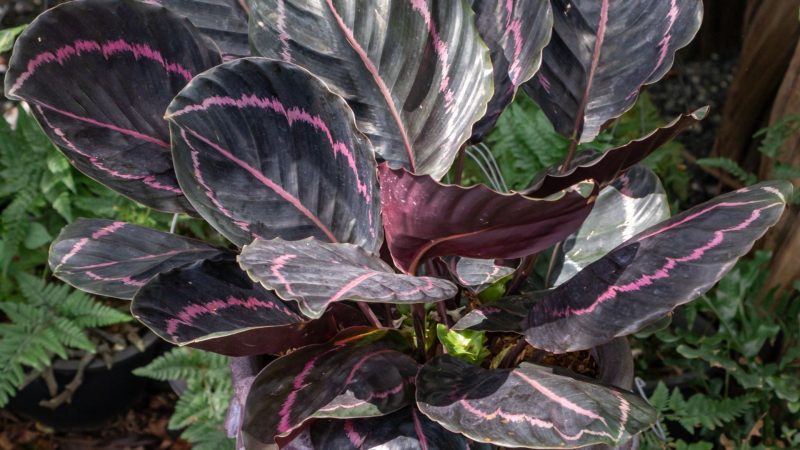
Calathea Dottie is a very sensitive plant, and it reacts dramatically if there is something wrong. If their leaves are curling, it means that the plant is starting to get dehydrated, and it is conserving water. The three possible reasons for curling leaves are underwatering, low humidity level, and too much light.
Common Problems With Calathea Dottie
Having Calathea Dottie will be met with some problems. Some of them may have similar symptoms but are easy to detect. Below is the summary of their common problems, along with their symptoms and how to solve them:
1. Lack of Watering
Symptoms:
- Curling leaves.
- Brown leaf tips.
- Drooping leaves.
Solutions:
- Monitor the soil if it is getting dry quickly.
- Make sure that the drainage holes are not too big.
- Water your plant regularly.
- Try moving your plant in an area with lower light.
2. Overwatering
Symptoms:
- Mushy stems.
- Yellow leaves.
- Brown leaf tips.
- Drooping leaves.
- Foul smell due to root rot.
Solutions:
- Make sure that the drainage holes are sufficient and big enough. Water should go down for only a few seconds.
- Water your plant less but maintain consistent moist on the soil.
- Make sure that the pot is not too big for your plant. Repot if necessary.
- Try increasing the light or moving your plant to a brighter place.
3. Too Much Light
Symptoms:
- Leaves patterns start to fade.
- Brown leaf tips.
- Crispy and burnt leaves.
- Curling leaves.
Solutions:
- Move the plant slightly away from the window.
- Cut brown or dying leaves.
4. Lack of Light
Symptoms:
- Yellow leaves.
- Leaves are turning dry.
Solution:
- Move your plant to a brighter place or closer to the window but not under direct sunlight.
5. Inconsistent Humidity
Symptoms:
- Curling leaves.
- Drooping leaves.
Solutions:
- Use a humidifier. Misting and pebble trays are also effective but only for a while.
- If you have multiple Calathea plants, put them together in one place only.
6. Pests
Symptoms:
- Leaves have holes, yellow or brown spots.
- The underside of leaves slowly loses color.
- Scales on leaves and stems.
- Water-soaked lesions.
Solutions:
- Quarantine the affected plant.
- Check for the presence of eggs, larvae, and adults of pests such as fungus gnats, mealy bugs, and spider mites. If possible, use a magnifying glass.
- Avoid algae growth in areas around your plants.
- If possible, reduce watering frequency.
- Destroy infected plants, if necessary.
- Try spraying diluted neem oil all over the plant every week.
- Avoid using pesticides with chemicals. Read the label carefully.
Frequently Asked Questions
Is Calathea a Species?
Calathea is not a species but rather a genus, which is a rank higher than species but a rank lower to family. A genus can have lots of species, while species can have many subspecies. As mentioned above, Calathea plants belong to the Marantaceae family and are the largest genus among them.
Is Calathea Good for Beginners?
Calatheas can be good for beginners, but they will face some challenges. Even experienced house plant hobbyists can also fail because they did not care enough for their Calatheas. But still, it does not mean that all beginners will fail on their first try. In short, Calathea plants are for everybody who loves plants.
Is Calathea Dottie Safe Around Children and Pets?
Calathea Dottie is safe around children and pets. In fact, all types of Calathea plants are non-toxic, which is why you can safely plant them indoors as an added decoration or give them as gifts during the holiday season. However, eating these plants may cause stomach upset, but not life-threatening.
Does Calathea Dottie Have Similar Care Needs to Other Calathea?
Calathea Dottie has the same requirements as the other types of Calathea, especially with its mother species, Calathea roseopicta. All of them are sensitive to direct sunlight, low humidity levels, lack of watering, and over-fertilization. Any of these mismanagement practices can eventually kill them.
Can I Keep Calathea Dottie With My Other Calathea Plants?
You can keep Calathea Dottie with your other Calatheas. In fact, this is a better idea than putting them in separate locations since they have the same requirements. Once they are all in one place only, you can easily monitor them and detect if there are some problems. Thus, you can take immediate action.
Where Do You Cut Calathea Leaves?
Cutting leaves of Calathea plants is only done if they are dead or dying. If pruning is necessary, get a pair of pruning scissors and cut the stem with the unwanted leaves. If a leaf has yellow or brown edges, you don’t need to remove the entire leaf. Instead, trim only its tips. This way, you can still save the leaf.
How Do You Make Calathea Bushy?
All Calathea plants grow very fast, as long as you take good care of them. Don’t put it under direct sunlight and water it regularly if you want to make your Calathea plant bushy and beautiful. Providing them with the correct temperature and relative humidity and cutting dead leaves will also encourage growth.
Summary
Calathea Dottie is an extraordinary plant and needs extraordinary care. But once you have mastered the techniques in providing its needs, you will feel absolute joy every time you see its leaves moving gracefully at night. The rustling sound the plant creates as it closes its leaves is a way of saying, “Thank you.”
Related: 25 Best Purple House Plants to Grow at Home
List of Sources
Which Holiday Plants Are Safe for My Cats and Dogs?
Molecular Phylogeny and Redefined Generic Limits of Calathea (Marantaceae)
Under the Solano Sun – Seasonal Observations of the UCCE Master Gardeners: Tradescantia vs Calthea